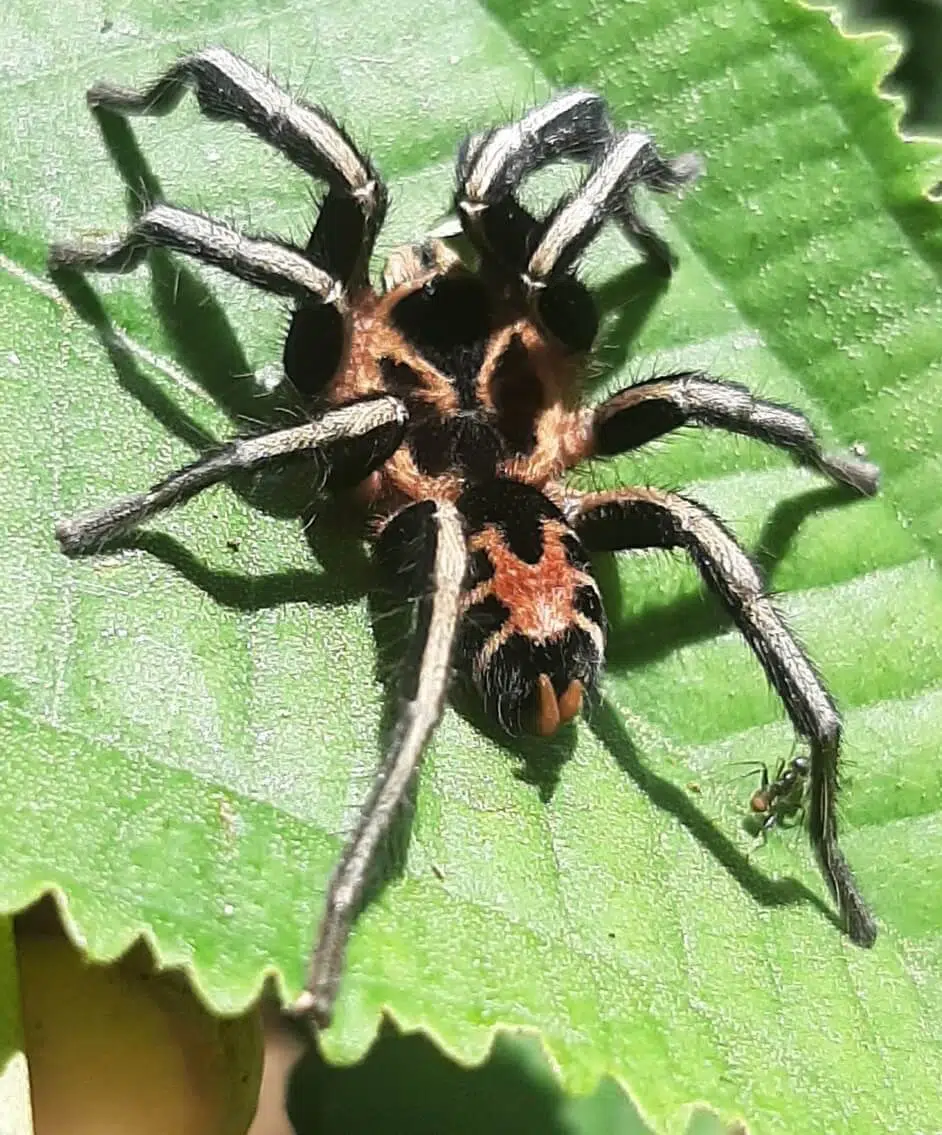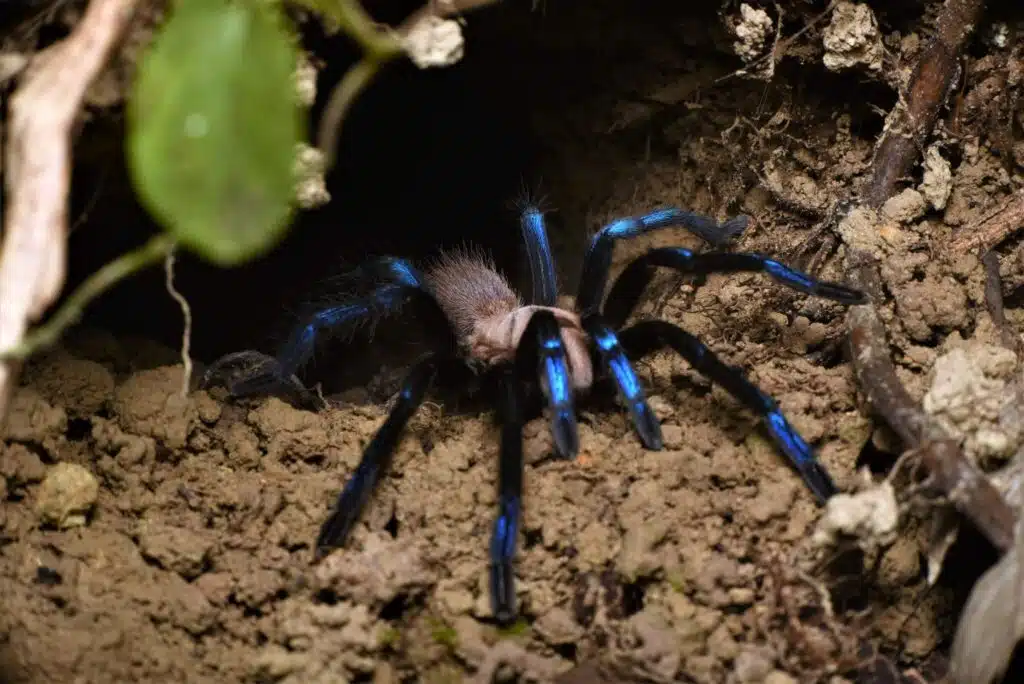If you are looking at owning a tarantula as a pet and want a colorful variety, then there are 18 colorful tarantulas you can choose from.
Tarantulas are the largest arachnids with a wide variety available and they all look different. They are identified by their hair and size. Most of them tend to be brown, black, or gray in color, but then there are the colorful options.
Continue reading below to learn more about the 18 colorful tarantulas.
18. Monocentropus balfouri
Scientific name: Monocentropus balfouri.
Common name: Socotra baboon tarantula, Socotra blue baboon tarantula.
The Monocentropus balfouri is better known as the Socotra baboon tarantula or Socotra blue baboon tarantula.
It is considered one of the most beautiful and colorful tarantulas that grow to 12cm.

While they are not the biggest tarantula, they are truly beautiful and can co-habitat and do well in a community enclosure.
They are a calm and relaxed tarantula, but they can protect themselves if you provoke them. They are also exceptionally fast.
Further Reading:
17. Davus pentaloris

Scientific name: Davus pentaloris.
Common name: Guatemalan tiger rump, wasp tarantula.
The Davus pentaloris is the Guatemalan Tiger Rump or Wasp Tarantula and should not be confused with the Davus fasciatus or Costa Rican Tiger Rump.
These tarantulas come from Guatemala and have beautiful red or copper coloring with dark black legs with blue noticeable on those that have recently molted.
They have red, orange, or pink on their abdomen and carapace, making them a beautiful species.
They are dwarf tarantulas, so they don’t grow too large.
They are known for creating a lot of webbing.
This is a nervous spider and will try and hide if disturbed.
16. Brachypelma boehmei

Scientific name: Brachypelma boehmei.
Common name: Mexican fireleg, Mexican rustleg tarantula.
Mexican fire legs are beautiful and colorful tarantulas. They are bright rust to red in color with fluffy hairs on their legs with light red to brown carapace and a dark abdomen.
This is a nervous species and will hide and flick urticating bristles for no reason. They are great burrowers, spending most of their time in burrows or shelters.
15. Harpactira pulchripes

Scientific name: Harpactira pulchripes.
Common name: golden blue-legged baboon spider.
The Golden blue leg baboon is not a tarantula for the beginner hobbyist, even though they appear to have a relaxed personality.
They are illegal in some countries, so ensure you can have one in your home before purchasing.
These tarantulas have ash blue legs with colors ranging from dark and light brown to black, gold, and orange with black markings on the abdomen and carapace.
14. Pterinochilus murinus

Scientific name: Pterinochilus murinus.
Common name: orange baboon tarantula, OBT, Mombasa golden starburst tarantula.
This tarantula is also known as the Orange baboon tarantula, Mombasa Golden Starburst, and the Usamabara Orange baboon and they are not suitable for beginner tarantula owners.
They are also illegal in some countries, so ensure they are legal in your country before purchase.
They are exceptionally moody spiders and should not be handled. It is exceptionally defensive and aggressive and will fight with just about anything.
This tarantula creates webbed tunnels, where it lives.
They also have a fast growth rate.
Further Reading:
13. Nhandu chromatus

Scientific name: Nhandu chromatus.
Common name: Brazilian red and white, white-striped bird eater.
The Nhandu chromatus is also known as the Brazilian red and white or the White-striped bird eater.
They have striking colors and grow large, around 18cm.
They are very bold and will spend their time out in the open.
They are feisty with a cheeky attitude, making them interesting for beginner tarantula owners looking for a tarantula with beautiful coloration.
They grow large and will spend their time out in the open, ideal for display enclosures.
They are good eaters, but they will bolt for cover if provoked.
12. Cyriocosmus leetzi

Scientific name: Cyriocosmus leetzi.
Common name: Columbian dwarf tarantula.
This is a dwarf tarantula that stays out in the open with great coloration.
They are relatively docile and will hide rather than fight, making them ideal for beginner hobbyists.
They make heavy webs.
Adults reach a 2” diagonal leg span with a shorter life span of up to seven years of females and a third of that for males.
They have beautiful coloration with black and orange stripes on the carapace and abdomen that become more apparent as they get older.
They should not co-habitat, as they will eat other tarantulas.
11. Birupes simoroxigorum

This is a relatively new species of tarantula with electric blue legs and a creamy toffee-colored body.
They are native in Malaysia, small in size and fit into the center of your palm.
Known for their hairy legs and their skittish behavior, they are a great addition to any hobbyist.
10. Theraphosinae sp. Panama
Scientific name: Theraphosinae sp Panama.
Common name: Lava Spider.
This beautiful tarantula can be a welcome addition to any enclosure with their bright orange with black on their legs and back.
9. Caribena versicolor

Scientific name: Caribena versicolor.
Common name: Martinique red tree spider, Martinique pinktoe.
This tarantula is better known as the Martinique red tree spider or Antilles pink toe. They are one of the most beautiful species.
They are arboreal. They are a bit more feisty than some of the other tarantulas, they are fun to watch with blue fluffy slings.
8. Pterinopelma sazimai

Scientific name: Pterinopelma sazimai.
Common name: Brazilian blue tarantula, Sazima’s tarantula, Iridescent Blue Tarantula
This tarantula is better known as the Brazilian blue and comes from South America.
It is a blue tarantula. They do look black with red hairs at first, but with some light, the blue shines through.
They do have arboreal traits but prefer to burrow.
They are nervous and skittish and will flick their urticating bristles if annoyed.
7. Poecilotheria metallica

Scientific name: Poecilotheria metallica.
Common name: Gooty sapphire ornamental.
The Poecilotheria metallica is also known as the Gooty Sapphire Ornamental and is not suitable for beginners.
They are one of the most beautiful tarantulas in the world and are very sought after by hobbyists. They start out rather dull and gray, but soon mature with blue, white, and yellow.
Males are smaller and not as bright as the female. Females lose their vibrant blue color and turn black or gray.
They are fast growers that live in holes and crevices, they will get defensive.
6. Ephebopus cyanognathus

Scientific name: Ephebopus cyanognathus.
Common name: blue fang tarantula.
This tarantula is also known as the blue fang skeleton tarantula and is a beautiful bird spider from French Guiana.
They prefer to burrow and create chambers with leaf litter as an entrance. They are very nervous tarantulas, but also very defensive, along with being exceptionally fast. They will bite.
5. Xenesthis intermedia

This is another of the beautiful and colorful tarantulas that are bright pink on their backs. A great addition to the display enclosure, these are great burrowers that will come out to explore.
4. Haploclastus devamatha
Scientific name: Haploclastus devamatha.
Common name: Indian Rainbow.
The Haploclastus devamatha is also known as the Indian Rainbow and are very interesting looking tarantulas from India. These tarantulas are very colorful with a metallic sheen. They have blues to turquoise that start as a dull brown.
They are not large in size. They will do a threat pose if they feel they are threatened and dig deep burrows of up to thirty centimeters.
3. Chromatopelma cyaneopubescens

Scientific name: Chromatopelma cyaneopubescens.
Common name: greenbottle blue tarantula.
The Green bottle blue tarantula is a bird spider that is beautiful to look at with a range of colors from gold to pink with black. This spider looks as though it is wearing black boots with colors changing as the spider gets older.
They are not shy, making them ideal for a display enclosure. They create beautiful webbed hammocks and tunnels.
2. Dolichothele diamantinensis

Scientific name: Dolichothele diamantinensis.
Common name: Brazilian Blue Dwarf Beauty.
The Dolichothele diamantinensis, also known as the Brazilian blue dwarf beauty, is a terrestrial tarantula from Brazil, growing to a 3” leg span.
It is fast growing with females living to around 15 years and males to 3 years.
They are recommended for intermediate hobbyists.
This is such a beautiful tarantula that is not that big but makes up for it with color. They maintain their bright colors and do not have urticating hairs.
They are skittish and will bolt quickly, which makes them unsuitable for beginner hobbyists.
1. Typhochlaena seladonia

Scientific name: Typhochlaena seladonia.
Common name: Brazilian jewel tarantula, Candy shop spider.
They Typhochiaena seladonia is better known as the Brazilian jewel tarantula or Candy shop spider.
They are not suitable for beginner hobbyists, as they are exceptionally sensitive to incorrect habitat conditions.
These tarantulas are very attractive for a dwarf arboreal species. They do create shelters on the ground, even though they prefer to be in the trees. They will make home wherever ample food passes.
Further Reading: